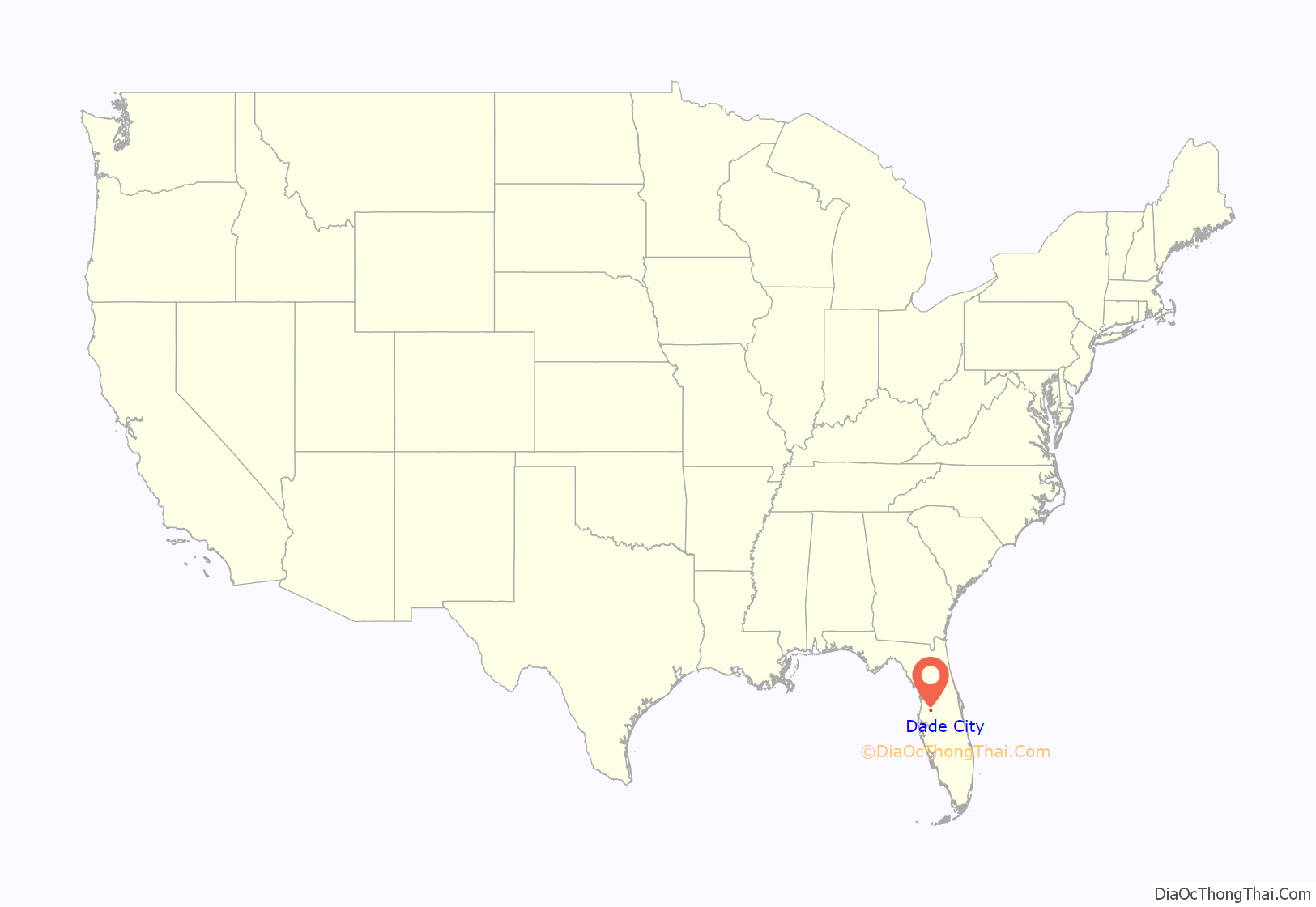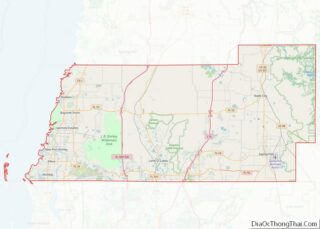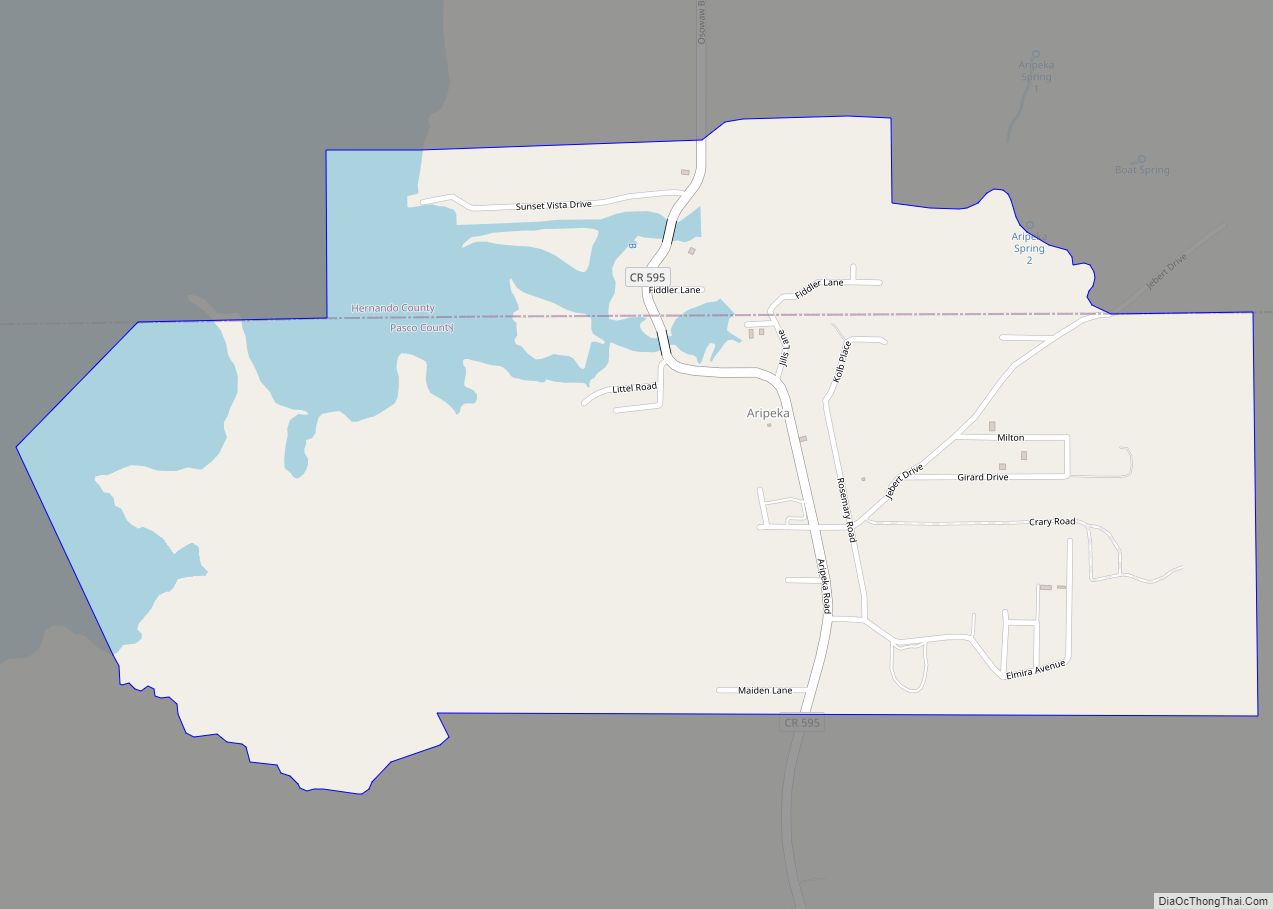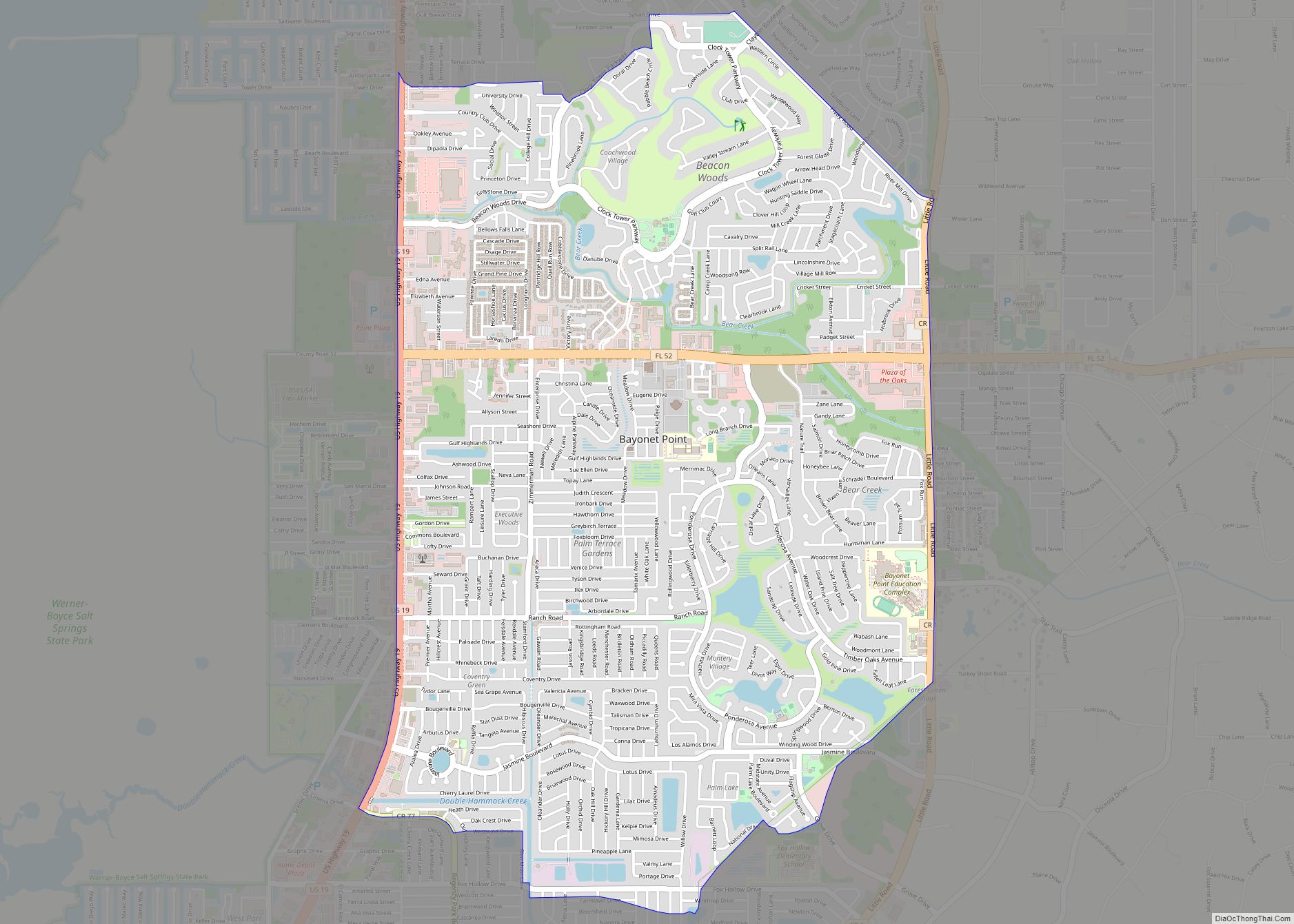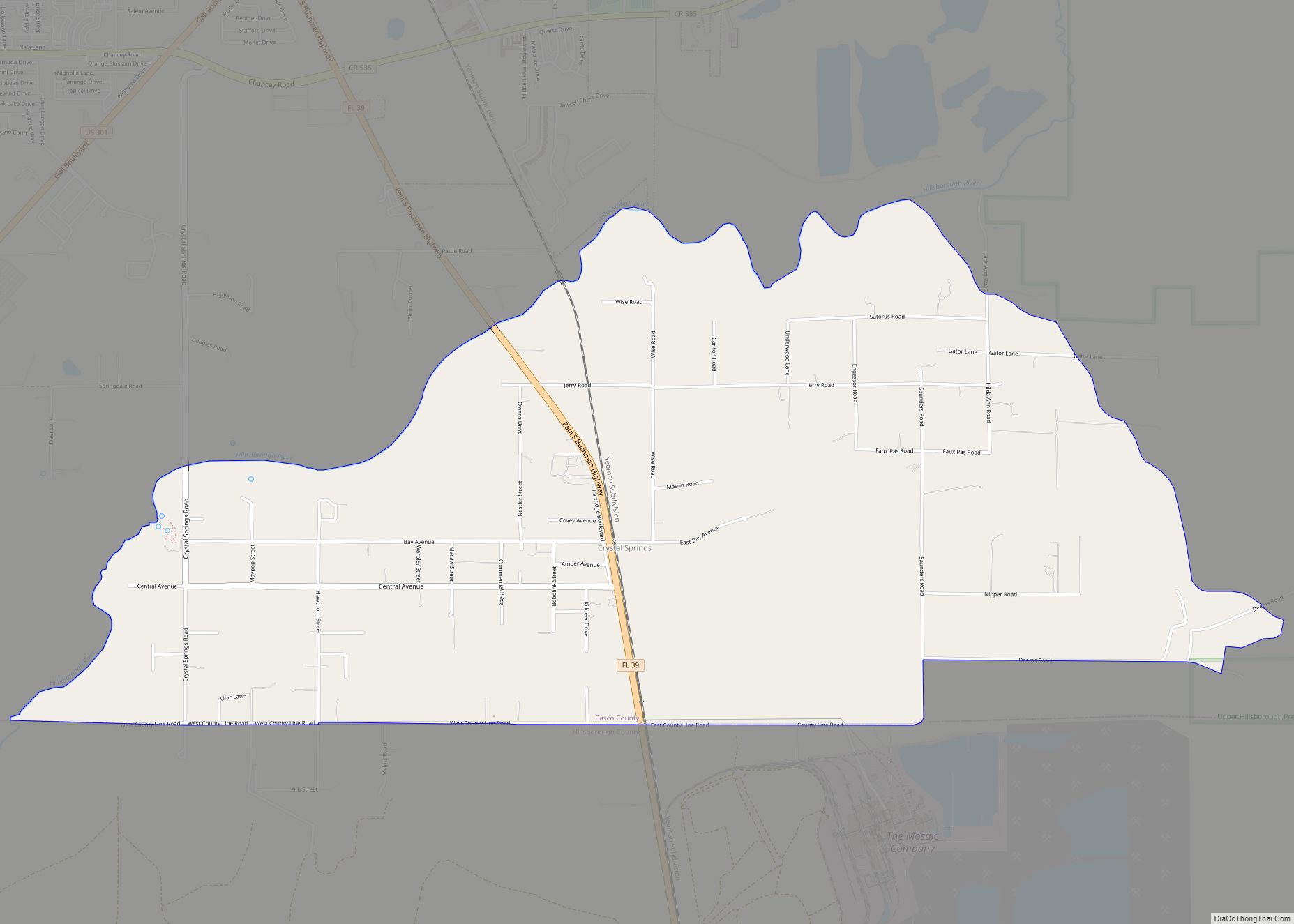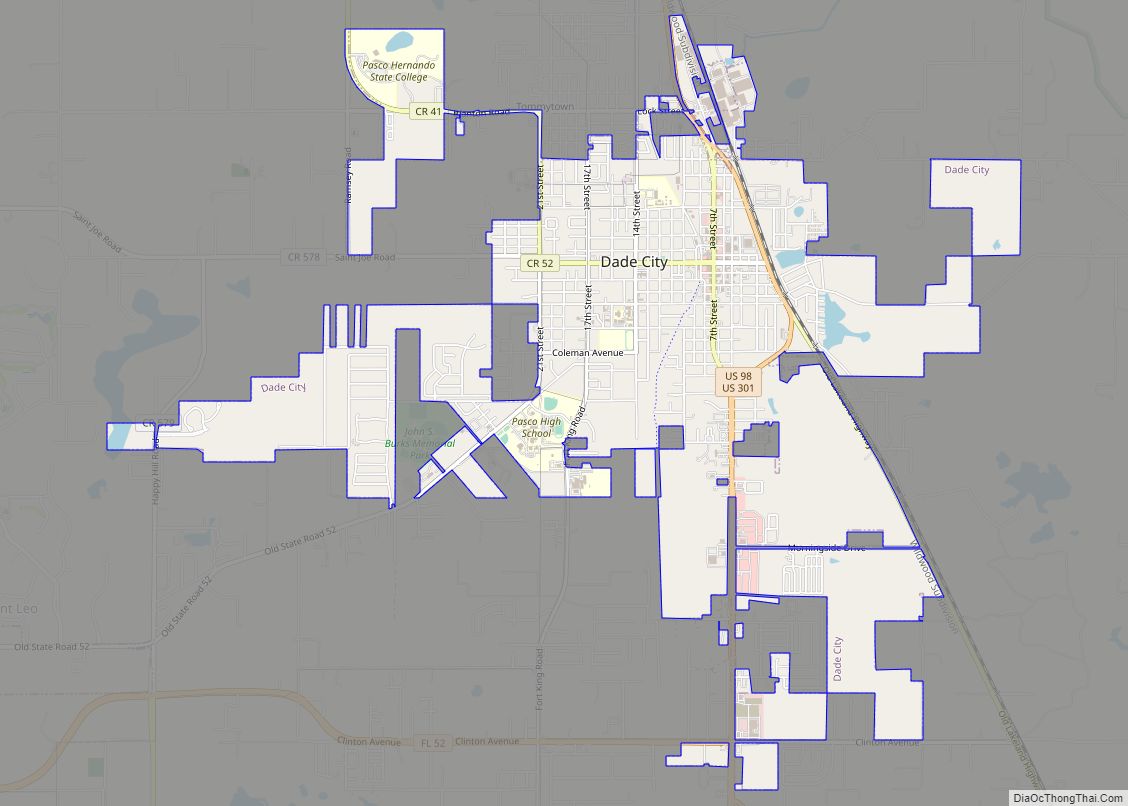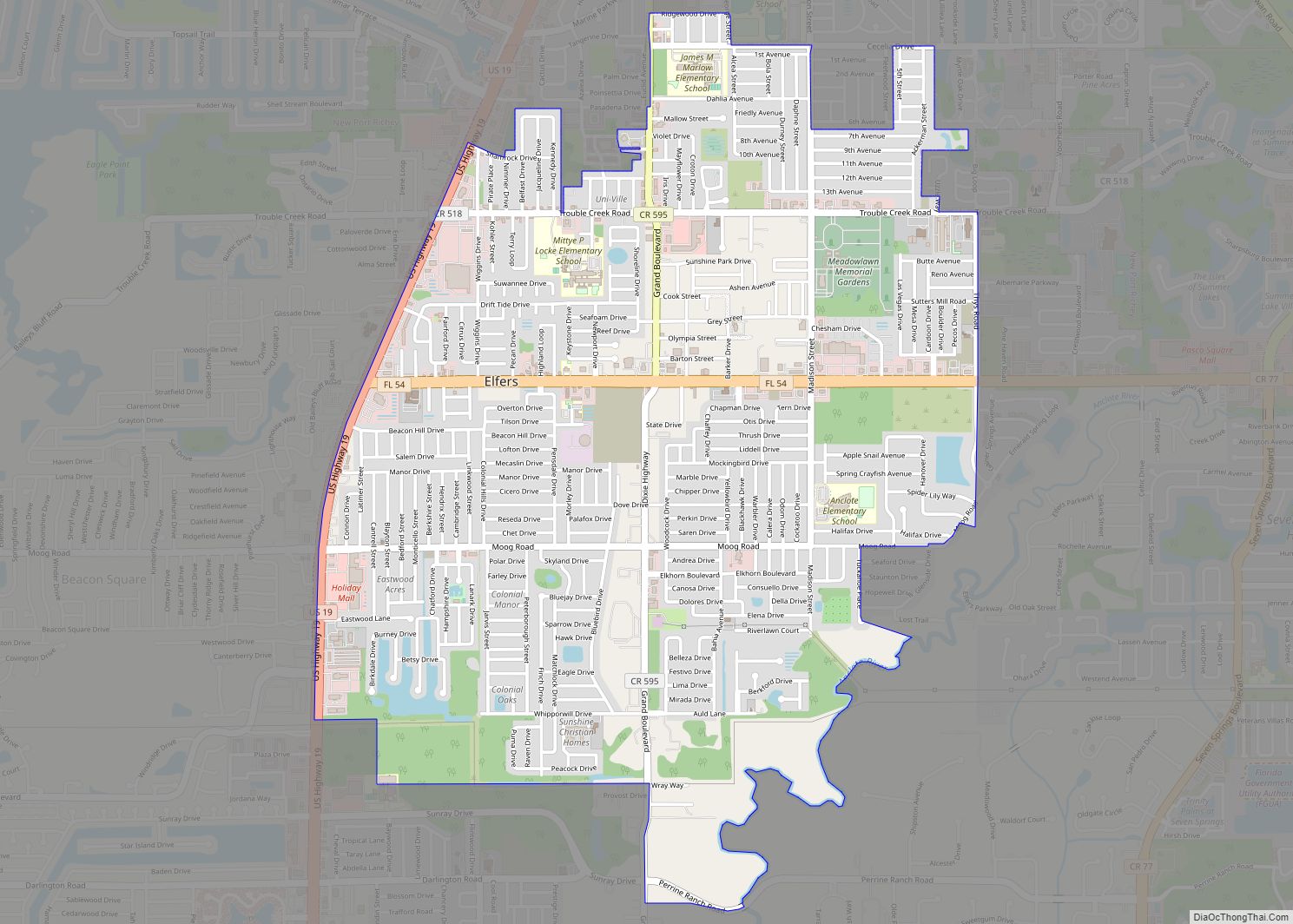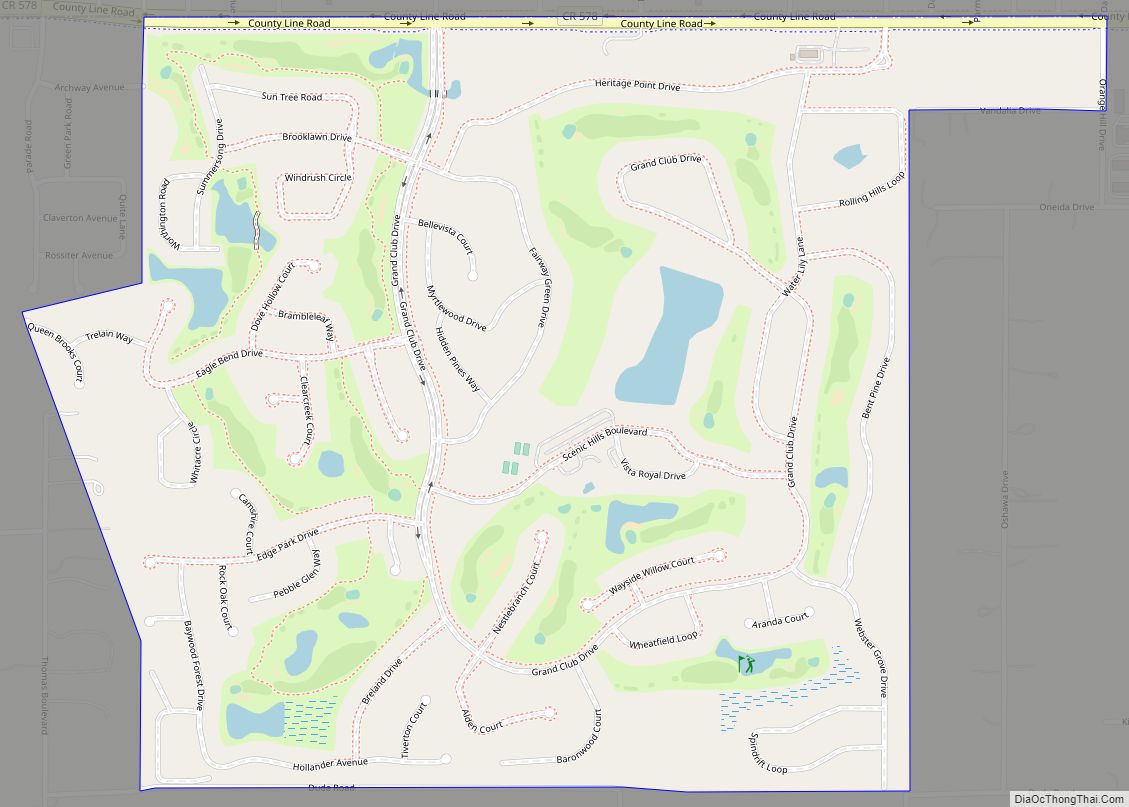Dade City is a city in and the county seat of Pasco County, Florida, United States. It is located in the Tampa Bay Area, north east of Tampa and south west of Orlando. The population was 7,275 as of the 2020 census.
The city was named after Maj. Francis L. Dade who served, and was killed in action, during the Second Seminole War.
| Name: | Dade City city |
|---|---|
| LSAD Code: | 25 |
| LSAD Description: | city (suffix) |
| State: | Florida |
| County: | Pasco County |
| Elevation: | 118 ft (36 m) |
| Total Area: | 6.89 sq mi (17.85 km²) |
| Land Area: | 6.68 sq mi (17.31 km²) |
| Water Area: | 0.21 sq mi (0.53 km²) |
| Total Population: | 7,275 |
| Population Density: | 1,088.42/sq mi (420.22/km²) |
| ZIP code: | 33523, 33525, 33526 |
| Area code: | 352 |
| FIPS code: | 1216125 |
| GNISfeature ID: | 0281254 |
| Website: | www.dadecityfl.com |
Online Interactive Map
Click on ![]() to view map in "full screen" mode.
to view map in "full screen" mode.
Dade City location map. Where is Dade City city?
History
An earlier European-American community known as Fort Dade existed nearby in the 1870s and 1880s. The railroad was constructed a few miles to the east, and business owners chose to relocate a few miles to the east to be near it. The newer town became known as Dade City. The name became official when the Hatton post office was changed to Dade City on December 18, 1884.
Dade City was initially incorporated in 1884 or 1885. That incorporation seems to have been forgotten subsequently, and the city was reincorporated in 1889. When Pasco County was formed from the southern section of Hernando County in 1887, Dade City became the county seat of the new county, first temporarily and later permanently, by a popular vote.
The Pioneer Florida Museum, which opened on Labor Day, 1975, showcases the life of European-American pioneers in Central Florida. Its artifacts and exhibits include a 1913 locomotive, a Methodist church, a house built before the American Civil War, an old school, and an old train depot from Trilby, Florida.
The Hugh Embry Library, currently located on 4th Street, was started in 1904 when its namesake, then 25, was recovering from an illness. Embry had a strong desire to read, but at that time there was no public library in Dade City. He solicited donations of books from local households, and developed a small library in the Embry home on Church Street. (This is now the site of the U.S. Post Office.)
His efforts helped generate enthusiasm in the community for a more extensive library, culminating in the development of the Pasco County Library Association in 1905. After Embry’s death at the age of 28 due to tuberculosis, the library initially faltered. Efforts of active community members and civic organizations such as the Dade City Woman’s Club kept it operating. The library was relocated several times over the next five decades, finally reaching its current location in 1963. The library underwent a complete renovation in the late 1980s. The current 7,200-square-foot (670 m) building opening in 1991.
The Crescent Theatre was Dade City’s main movie theater from its opening in 1926 until it closed in 1950. It was located on the northeast corner of South 5th Street and Florida Avenue. The front facade/entry to the original building was preserved while other renovations were made for adaptive reuse. A metal structure was added in the 1990s. Today the building is used as a non-profit Seniors’ Services center.
The Pasco Theater, built as a movie theater on South 7th Street, operated from 1948 until 1999. The Pasco theater has since been demolished.
Lawrence Puckett (1906–1985) settled in Dade City in 1925. He later became involved in politics and served as mayor of Dade City from 1981–1983 and as a member of the Dade City Commission from 1976 until his death in 1985. His recollections of the city were published by the Pasco County Centennial Committee. They date from his arrival as a young man of 19. Puckett describes Dade City before and after the Florida land boom as “a typical southern agriculture area, where the few well-to-do controlled the economy and the poor white folks and Negroes did the work for minimal pay. In other words, folks here were either quite well-to-do or very damn poor”. Puckett described Dade City as it existed during the Florida boom, with its various shops, streets, and buildings. Most of these had changed significantly by the time he was writing.
With the Florida land boom, people were streaming into the state, usually sticking to the Eastern Coast. The overall economic effect was to drive up property prices all across the state. For Dade City, Puckett estimated that the top money-making ventures were either real estate, business related to real estate, or the production of moonshine.
He said that the increase of people and capital into Dade City had a profound effect on its culture:
During World War II, the government established a prisoner-of-war camp in Dade City. The prisoners were German soldiers from Field Marshal Erwin Rommel’s Afrika Korps, who were captured in battles in North Africa in 1942-1943. They were put to work, producing limestone bricks, building warehouses, and making boxes. The POW camp operated from approximately 1942 to the spring of 1946. The site has been redeveloped as the Pyracantha Park Civic Center.
Dade City Road Map
Dade City city Satellite Map
Geography
Dade City is located at 28°21′42″N 82°11′36″W / 28.361774°N 82.193319°W / 28.361774; -82.193319.
According to the United States Census Bureau, the city has a total area of 3.4 square miles (8.8 km), of which 3.3 square miles (8.5 km) is land and 0.1 square miles (0.26 km) (2.96%) is water.
Dade City contains gently rolling topography with elevations from 60ft to 100ft.
See also
Map of Florida State and its subdivision:- Alachua
- Baker
- Bay
- Bradford
- Brevard
- Broward
- Calhoun
- Charlotte
- Citrus
- Clay
- Collier
- Columbia
- Desoto
- Dixie
- Duval
- Escambia
- Flagler
- Franklin
- Gadsden
- Gilchrist
- Glades
- Gulf
- Hamilton
- Hardee
- Hendry
- Hernando
- Highlands
- Hillsborough
- Holmes
- Indian River
- Jackson
- Jefferson
- Lafayette
- Lake
- Lee
- Leon
- Levy
- Liberty
- Madison
- Manatee
- Marion
- Martin
- Miami-Dade
- Monroe
- Nassau
- Okaloosa
- Okeechobee
- Orange
- Osceola
- Palm Beach
- Pasco
- Pinellas
- Polk
- Putnam
- Saint Johns
- Saint Lucie
- Santa Rosa
- Sarasota
- Seminole
- Sumter
- Suwannee
- Taylor
- Union
- Volusia
- Wakulla
- Walton
- Washington
- Alabama
- Alaska
- Arizona
- Arkansas
- California
- Colorado
- Connecticut
- Delaware
- District of Columbia
- Florida
- Georgia
- Hawaii
- Idaho
- Illinois
- Indiana
- Iowa
- Kansas
- Kentucky
- Louisiana
- Maine
- Maryland
- Massachusetts
- Michigan
- Minnesota
- Mississippi
- Missouri
- Montana
- Nebraska
- Nevada
- New Hampshire
- New Jersey
- New Mexico
- New York
- North Carolina
- North Dakota
- Ohio
- Oklahoma
- Oregon
- Pennsylvania
- Rhode Island
- South Carolina
- South Dakota
- Tennessee
- Texas
- Utah
- Vermont
- Virginia
- Washington
- West Virginia
- Wisconsin
- Wyoming
